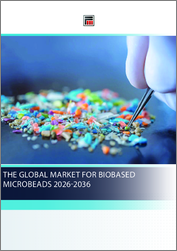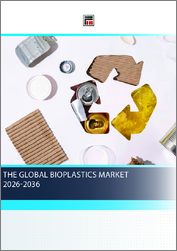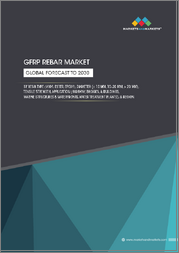
|
시장보고서
상품코드
1740242
세계의 바이오 마이크로비즈 시장(2026-2036년)The Global Market for Biobased Microbeads 2026-2036 |
||||||
바이오 마이크로비즈 시장은 환경 규제 강화와 기존 플라스틱 마이크로비즈를 대체할 수 있는 친환경적인 대안에 대한 소비자 수요로 인해 거대한 지속가능한 소재 산업에서 빠르게 성장하고 있는 분야입니다. 이 미세한 구형 입자는 일반적으로 직경이 1-1,000 마이크로미터이며, 식물성 셀룰로오스, 조류, 농업 폐기물, 생분해성 고분자 등 재생 가능한 생체 유래 물질로 만들어집니다. 세계 바이오 마이크로비즈 시장은 퍼스널케어 제품에 포함된 합성 플라스틱 마이크로비즈에 대한 규제로 인해 큰 성장세를 보이고 있습니다. 미국, 캐나다, 영국, EU 여러 국가를 포함한 국가들은 환경 잔류성과 해양 생태계에 대한 잠재적 유해성을 이유로 씻어내는 유형의 화장품에 포함된 플라스틱 마이크로비즈의 사용을 금지하고 있습니다. 이러한 규제 환경은 생분해성을 유지하면서 유사한 기능적 특성을 제공하는 바이오 대체품에 큰 기회를 제공합니다.
바이오 마이크로비즈 시장에는 다양한 천연 소재와 생분해성 폴리머가 포함되어 있으며, 각각 고유한 성능 특성과 응용 가능성을 제공합니다. 전분, 셀룰로오스, 키틴과 같은 다당류부터 콜라겐과 카제인을 포함한 단백질, 폴리하이드록시알카노에이트(PHA)와 폴리유산(PLA)과 같은 폴리에스테르의 기술 혁신으로 인해 재료 상황은 계속 확대되고 있습니다. 또한, 리그닌과 알긴산과 같은 새로운 소재는 산업 전반에 걸쳐 특수 용도에 새로운 기회를 제공합니다.
바이오 마이크로비즈의 주요 용도는 여러 산업에 걸쳐 있으며, 퍼스널케어 및 화장품이 가장 큰 시장 부문입니다. 이 제품들은 페이스 스크럽, 바디워시, 치약, 치약에서 부드러운 스크럽제 역할을 하며, 소비자가 기대하는 촉감과 미적 특성을 제공하는 동시에 환경적 우려에 대응하고 있습니다. 퍼스널케어 외에도 바이오 마이크로비즈는 의약품의 약물 전달 시스템, 농업의 제어 방출 비료 운반체, 생분해성 연마제로서 산업 공정에 적용되고 있습니다.
경쟁 구도에는 새로운 바이오 솔루션을 개발하는 기존 화학 기업들과 혁신적인 스타트업들이 혼재되어 있습니다. 주요 기업에는 목재 펄프와 면화에서 셀룰로오스 기반 마이크로 비드를 생산하는 기업이 포함되며, 새로운 기술은 조류 유래 입자 및 농업 폐기물의 전환에 초점을 맞추었습니다. 제조 공정은 일반적으로 원하는 입자 크기 분포 및 기능적 특성을 달성하기 위해 제어 된 침전, 분무 건조 또는 특수 중합 기술을 포함합니다.
시장 성장 촉진요인으로는 환경 규제 강화, 기업의 지속가능성 노력, 미세 플라스틱 오염에 대한 소비자의 인식 증가 등이 있습니다. 특히 뷰티 및 퍼스널케어 산업에서 '클린' 포뮬러로의 전환은 채택을 가속화하고 있습니다. 또한, 기술 발전으로 바이오 마이크로 비드의 성능 특성이 개선되어 효과와 저장 안정성에 대한 초기 우려를 해결하고 있습니다.
그러나 시장은 여러 가지 문제에 직면해 있습니다. 바이오 대체품의 생산 비용은 일반적으로 기존 플라스틱 마이크로 비드의 생산 비용을 초과합니다. 그러나 이 차이는 규모와 기술 향상으로 점점 줄어들고 있습니다. 안정적인 품질과 신뢰할 수 있는 원자재 조달을 위해서는 지속적인 투자가 필요하기 때문에 공급망 개발은 여전히 우려되는 문제입니다. 또한, 생분해율과 환경 역학은 여전히 활발한 연구와 규제 조사가 진행되고 있는 분야입니다.
지역별 시장 역학은 크게 다르며, 유럽이 규제 압력과 시장 채택에서 선두를 달리고 있으며, 북미가 그 뒤를 잇고 있습니다. 아시아태평양 시장은 특히 엄격한 환경 기준을 도입한 국가에서 관심이 높아지고 있습니다. 시장 구조는 기존 플라스틱 마이크로비즈를 직접 대체하는 것과 바이오 대체품의 고유한 특성을 활용하여 새로운 용도를 개발하는 것을 포함합니다. 향후 시장 전망은 규제 프레임워크의 확대, 기업의 환경적 노력 증가, 원료 및 가공 기술의 지속적인 혁신에 힘입어 건전한 시장 전망이 예상됩니다. 업계 분석가들은 다양한 용도의 규제 준수와 지속가능한 대체품의 자발적 채택으로 인해 시장이 확대되고 향후 10년간 두 자릿수 성장을 유지할 것으로 예상하고 있습니다.
세계의 바이오 마이크로비즈 시장에 대해 조사 분석했으며, 시장 성장 촉진요인, 기술 혁신, 응용 분야, 경쟁 역학 등의 정보를 전해드립니다.
목차
제1장 마이크로 플라스틱 시장
- 제품에 첨가된 마이크로 플라스틱
- 분류
- 기능과 용도
- 마이크로 플라스틱에 관한 법률
- REACH
- 미국
- 캐나다
- 호주
- 아시아
- 환경에 대한 영향 평가
- 해양 오염과 마이크로 플라스틱 축적
- 해양생물에 대한 독성의 영향
- 인간 건강에 대한 영향
제2장 바이오 마이크로비즈 재료
- 마이크로 플라스틱 대체품으로서의 사용
- 생분해 메커니즘과 시간 범위
- 천연 경질 재료
- 천연 폴리머
- 다당류
- 단백질
- 폴리에스테르
- 기타 천연 폴리머
- 제조 기술과 프로세스
- 용해 가공 및 압출 기법
- 용제 베이스 생산 방식
- 에멀전 및 스프레이 드라이 기술
- 품질관리 및 입도 분포
- 규제 구조와 규격
- 생분해성 시험 규격(ASTM, ISO)
- 식품 접촉과 화장품 안전 규제
- 국제 인정 프로그램
제3장 바이오 마이크로비즈 시장
- 마이크로 플라스틱(1-50 마이크로 미터) 대체품 : 용도별, 시장별
- 천연 마이크로 플라스틱 대체품 시장 침투 가능성 : 시장별
- 시장 침투 장벽과 과제
- 채택 타임라인과 시장 준비도 평가
- 퍼스널케어
- 시장 개요
- 용도
- 브랜드 채택 사례 연구
- 소비자 수용성과 지불해 의욕
- 마이크로 플라스틱 총량 : 규모별(2024년-2036년)
- 화장품
- 시장 개요
- 용도
- 마이크로 플라스틱 총량 : 규모별(2024년-2036년)
- 농업 및 원예
- 시장 개요
- 용도
- 마이크로 플라스틱 총량 : 규모별(2024년-2036년)
- 페인트 및 코팅
- 시장 개요
- 용도
- 마이크로 플라스틱 총량 : 규모별(2024년-2036년)
- 비누 및 세제/유지관리 용품
- 시장 개요
- 용도
- 마이크로 플라스틱 총량 : 규모별(2024년-2036년)
- 석유 및 가스
- 시장 개요
- 용도
- 마이크로 플라스틱 총량 : 규모별(2024년-2036년)
- 의료용품
- 시장 개요
- 용도
- 마이크로 플라스틱 총량 : 규모별(2024년-2036년)
- 새로운 용도
- 3D 프린팅 및 적층 가공
- 텍스타일 및 섬유
- 식품 포장 및 생분해성 필름
- 시장 매출 분석
- 가격 탄력성과 비용 경쟁력 분석
제4장 세계 시장 규모
- 1차 미립자(메트릭톤 단위 수량)
- 시장별
- 지역별
- 바이오 마이크로비즈(MT)
- 원재료별
- 시장별
- 지역별
제5장 SWOT 분석과 시장이 해결해야 할 과제
- 바이오 마이크로비즈의 강점
- 약점과 기술적 한계
- 시장 기회와 성장 촉진요인
- 위협과 시장 리스크
- 시장 침투 중요 성공 요인
제6장 제조업체 개요(기업 40개사 개요)
제7장 보고서의 조사 방법
제8장 참고 문헌
LSH 25.06.16The market for biobased microbeads represents a rapidly evolving segment within the broader sustainable materials industry, driven by increasing environmental regulations and consumer demand for eco-friendly alternatives to conventional plastic microbeads. These microscopic spherical particles, typically ranging from 1 to 1000 micrometers in diameter, are derived from renewable biological sources such as plant cellulose, algae, agricultural waste, and biodegradable polymers. The global biobased microbeads market has experienced significant growth following regulatory restrictions on synthetic plastic microbeads in personal care products. Countries including the United States, Canada, the United Kingdom, and several EU nations have implemented bans on plastic microbeads in rinse-off cosmetics due to their environmental persistence and potential harm to marine ecosystems. This regulatory landscape has created substantial opportunities for biobased alternatives that offer similar functional properties while maintaining biodegradability.
The biobased microbeads market encompasses a diverse range of natural materials and biodegradable polymers, each offering unique performance characteristics and application potential. From polysaccharides like starch, cellulose, and chitin to proteins including collagen and casein, the material landscape continues to expand with innovations in polyesters such as polyhydroxyalkanoates (PHA) and polylactic acid (PLA). Additionally, emerging materials like lignin and alginate present new opportunities for specialized applications across industries.
Key applications for biobased microbeads span multiple industries, with personal care and cosmetics representing the largest market segment. These products serve as gentle exfoliants in facial scrubs, body washes, and toothpaste, providing the tactile and aesthetic properties consumers expect while addressing environmental concerns. Beyond personal care, biobased microbeads find applications in pharmaceuticals as drug delivery systems, in agriculture as controlled-release fertilizer carriers, and in industrial processes as biodegradable abrasives.
The competitive landscape features a mix of established chemical companies and innovative startups developing novel biobased solutions. Major players include companies producing cellulose-based microbeads from wood pulp and cotton, while emerging technologies focus on algae-derived particles and agricultural waste conversion. Manufacturing processes typically involve controlled precipitation, spray drying, or specialized polymerization techniques to achieve desired particle size distributions and functional properties.
Market growth drivers include strengthening environmental regulations, corporate sustainability commitments, and growing consumer awareness of microplastic pollution. The beauty and personal care industry's shift toward "clean" formulations has particularly accelerated adoption. Additionally, technological advances have improved the performance characteristics of biobased microbeads, addressing early concerns about effectiveness and shelf stability.
However, the market faces several challenges. Production costs for biobased alternatives typically exceed those of conventional plastic microbeads, though this gap is narrowing with scale and technological improvements. Supply chain development remains a consideration, as consistent quality and reliable sourcing of raw materials require ongoing investment. Additionally, biodegradation rates and environmental fate studies continue to be areas of active research and regulatory scrutiny.
Regional market dynamics vary significantly, with Europe leading in both regulatory pressure and market adoption, followed by North America. Asia-Pacific markets show growing interest, particularly in countries implementing stricter environmental standards. The market structure includes both direct replacement of existing plastic microbeads and development of new applications leveraging unique properties of biobased alternatives. Future market prospects appear robust, supported by expanding regulatory frameworks, increasing corporate environmental commitments, and continued innovation in raw materials and processing technologies. Industry analysts project sustained double-digit growth rates through the next decade, with market expansion driven by both regulatory compliance and voluntary adoption of sustainable alternatives across diverse applications.
"The Global Market for Biobased Microbeads: Market Report 2026-2036" provides critical insights into the rapidly evolving landscape of biobased microbeads from 2026 to 2036, analyzing market drivers, technological innovations, application segments, and competitive dynamics across multiple industries. Market segmentation analysis reveals significant opportunities across multiple application areas, with personal care and cosmetics leading adoption rates due to regulatory pressure and consumer demand. The agricultural and horticultural sectors present substantial growth potential for controlled-release applications, while paints and coatings, soap and detergents, oil and gas, and medical products offer diverse market entry points. Emerging applications in 3D printing, textiles, and food packaging represent future growth vectors for innovative market participants.
Manufacturing technologies and processes continue to evolve, with advances in melt processing, extrusion techniques, solvent-based production methods, and emulsion and spray-drying technologies enabling improved quality control and particle size distribution. These technological developments directly impact cost competitiveness and market penetration potential across various application segments.
Report contents include:
- Regulatory Landscape Analysis: Comprehensive examination of microplastics legislation across major markets including REACH compliance, US federal regulations, Canadian restrictions, Australian guidelines, and emerging Asian regulatory frameworks
- Material Technology Assessment: Detailed evaluation of natural hard materials, polysaccharides (starch, cellulose variants, chitin), proteins (collagen, gelatin, casein), polyesters (PHA, PLA), and other natural polymers (lignin, alginate)
- Manufacturing Process Innovation: Analysis of melt processing, extrusion techniques, solvent-based production, emulsion technologies, spray-drying methods, and quality control systems
- Market Penetration Barriers: Identification of technical limitations, cost competitiveness challenges, supply chain constraints, and regulatory compliance requirements
- Application Market Sizing: Quantitative analysis of microplastics volumes across personal care (2024-2036), cosmetics, agriculture and horticulture, paints and coatings, soap and detergents, oil and gas, and medical products
- Regional Market Dynamics: Geographic analysis covering North America, Europe, Asia-Pacific, and emerging markets with volume projections in metric tons
- Competitive Intelligence: Comprehensive profiles of 40+ leading companies developing biobased microbead technologies and commercial solutions. Companies profiled include
- Environmental Impact Assessment: Analysis of marine pollution mitigation, toxicological effects reduction, and human health implications
- Price Elasticity and Cost Analysis: Economic modeling of market adoption rates, price sensitivity, and cost-competitiveness factors
- Technology Readiness Assessment: Evaluation of commercialization timelines, market readiness levels, and adoption barriers across different application segments
- SWOT Analysis Framework: Systematic assessment of market strengths, weaknesses, opportunities, and threats affecting industry development
- Emerging Applications: Forward-looking analysis of 3D printing, textile applications, and food packaging opportunities
TABLE OF CONTENTS
1. THE MICROPLASTICS MARKET
- 1.1. Microplastics added to products
- 1.1.1. Classification
- 1.1.2. Function and applications
- 1.2. Microplastics legislation
- 1.2.1. REACH
- 1.2.2. United States
- 1.2.3. Canada
- 1.2.4. Australia
- 1.2.5. Asia
- 1.3. Environmental Impact Assessment
- 1.3.1. Marine pollution and microplastic accumulation
- 1.3.2. Toxicological effects on marine life
- 1.3.3. Human health implications
2. BIOBASED MICROBEADS MATERIALS
- 2.1. Use as an alternative to microplastics
- 2.2. Biodegradation mechanisms and timeframes
- 2.3. Natural hard materials
- 2.4. Natural polymers
- 2.4.1. Polysaccharides
- 2.4.1.1. Starch
- 2.4.1.1.1. Applications and commercial status
- 2.4.1.1.2. Companies
- 2.4.1.2. Cellulose
- 2.4.1.2.1. Microcrystalline cellulose (MCC)
- 2.4.1.2.1.1. Applications and commercial status
- 2.4.1.2.1.2. Companies
- 2.4.1.2.2. Regenerated cellulose microspheres
- 2.4.1.2.2.1. Applications and commercial status
- 2.4.1.2.2.2. Companies
- 2.4.1.2.3. Cellulose nanocrystals
- 2.4.1.2.3.1. Applications and commercial status
- 2.4.1.2.3.2. Companies
- 2.4.1.2.4. Bacterial nanocellulose (BNC)
- 2.4.1.2.4.1. Applications and commercial status
- 2.4.1.2.4.2. Companies
- 2.4.1.2.1. Microcrystalline cellulose (MCC)
- 2.4.1.3. Chitin
- 2.4.1.3.1. Applications and commercial status
- 2.4.1.3.2. Companies
- 2.4.1.1. Starch
- 2.4.2. Proteins
- 2.4.2.1. Collagen/Gelatin
- 2.4.2.1.1. Applications and commercial status
- 2.4.2.2. Casein
- 2.4.2.2.1. Applications and commercial status
- 2.4.2.1. Collagen/Gelatin
- 2.4.3. Polyesters
- 2.4.3.1. Polyhydroxyalkanoates
- 2.4.3.1.1. Applications and commercial status
- 2.4.3.1.2. Companies
- 2.4.3.2. Polylactic acid
- 2.4.3.2.1. Applications and commercial status
- 2.4.3.2.2. Companies
- 2.4.3.1. Polyhydroxyalkanoates
- 2.4.4. Other natural polymers
- 2.4.4.1. Lignin
- 2.4.4.1.1. Description
- 2.4.4.1.2. Applications and commercial status
- 2.4.4.1.3. Companies
- 2.4.4.2. Alginate
- 2.4.4.2.1. Applications and commercial status
- 2.4.4.2.2. Companies
- 2.4.4.1. Lignin
- 2.4.1. Polysaccharides
- 2.5. Manufacturing Technologies and Processes
- 2.5.1. Melt processing and extrusion techniques
- 2.5.2. Solvent-based production methods
- 2.5.3. Emulsion and spray-drying technologies
- 2.5.4. Quality control and particle size distribution
- 2.6. Regulatory Framework and Standards
- 2.6.1. Biodegradability testing standards (ASTM, ISO)
- 2.6.2. Food contact and cosmetic safety regulations
- 2.6.3. International certification programs
3. MARKETS FOR BIOBASED MICROBEADS
- 3.1. Alternatives to microplastics (1-50 micrometer), by application and market
- 3.2. Likelihood of market penetration of natural microplastic alternatives, by market
- 3.2.1. Market penetration barriers and challenges
- 3.2.2. Adoption timeline and market readiness assessment
- 3.3. Personal care
- 3.3.1. Market overview
- 3.3.2. Applications
- 3.3.3. Brand adoption case studies
- 3.3.3.1. Unilever
- 3.3.3.2. L'Oreal
- 3.3.3.3. Procter & Gamble
- 3.3.4. Consumer acceptance and willingness to pay
- 3.3.5. Total quantity of microplastics present 2024-2036 (MT), by scale
- 3.4. Cosmetics
- 3.4.1. Market overview
- 3.4.2. Applications
- 3.4.3. Total quantity of microplastics present 2024-2036, by scale
- 3.5. Agriculture and horticulture
- 3.5.1. Market overview
- 3.5.2. Applications
- 3.5.3. Total quantity of microplastics present 2024-2036 (MT), by scale
- 3.6. Paints & coatings
- 3.6.1. Market overview
- 3.6.2. Applications
- 3.6.3. Total quantity of microplastics present 2024-2036 (MT), by scale
- 3.7. Soap, detergents and maintenance products
- 3.7.1. Market overview
- 3.7.2. Applications
- 3.7.3. Total quantity of microplastics present 2024-2036 (MT), by scale
- 3.8. Oil and gas
- 3.8.1. Market overview
- 3.8.2. Applications
- 3.8.3. Total quantity of microplastics present 2024-2036 (MT), by scale
- 3.9. Medical products
- 3.9.1. Market overview
- 3.9.2. Applications
- 3.9.3. Total quantity of microplastics present 2024-2036 (MT), by scale
- 3.10. Emerging Applications
- 3.10.1. 3D printing and additive manufacturing
- 3.10.2. Textile and fibre
- 3.10.3. Food packaging and biodegradable films
- 3.11. Market value analysis
- 3.12. Price elasticity and cost-competitiveness analysis
4. GLOBAL MARKET SIZE
- 4.1. Primary microparticles (volume in Metric Tons)
- 4.1.1. By Market
- 4.1.2. By Region
- 4.2. Biobased microbeads (MT)
- 4.2.1. By Raw Materials
- 4.2.2. By Market
- 4.2.3. By Region
5. SWOT ANALYSIS AND MARKET CHALLENGES
- 5.1. Strengths of biobased microbeads
- 5.2. Weaknesses and technical limitations
- 5.3. Market opportunities and growth drivers
- 5.4. Threats and market risks
- 5.5. Critical success factors for market penetration



















